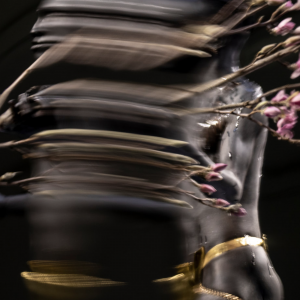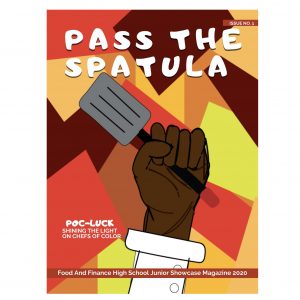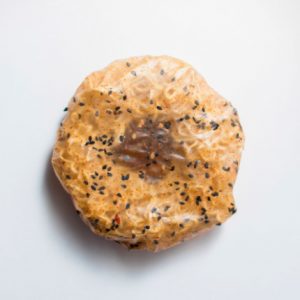Link About It: This Week’s Picks
Eco-friendly innovations, AI-produced portraits, upcycled watches and more fascinating tidbits from around the web

Industrial Designer Jexter Lim’s Adaptive Tableware for Visually Impaired People
 Singapore-based industrial designer Jexter Lim worked with visually impaired people on the development of Eatsy, his collection of adaptive tableware that streamlines eating and serving actions like scooping, aligning, pouring and transferring. The set consists of a plate, bowl, cup, and utensils—each of which incorporates subtle details that act as sensory cues and can be used by left- or right-handed people. In addition to making the process of dining and drinking easier, Lim’s thoughtful collection also avoids stigmatization. Read more, and see the collection at work, at Core77.
Singapore-based industrial designer Jexter Lim worked with visually impaired people on the development of Eatsy, his collection of adaptive tableware that streamlines eating and serving actions like scooping, aligning, pouring and transferring. The set consists of a plate, bowl, cup, and utensils—each of which incorporates subtle details that act as sensory cues and can be used by left- or right-handed people. In addition to making the process of dining and drinking easier, Lim’s thoughtful collection also avoids stigmatization. Read more, and see the collection at work, at Core77.
Durational Artist Miles Greenberg’s Uninterrupted 24-Hour Performance, “OYSTERKNIFE”
 Held within Montreal’s Centre Phi and presented through the Marina Abramović Institute (MAI), durational artist Miles Greenberg’s “OYSTERKNIFE” will be an uninterrupted 24-hour performance. Greenberg—whose six-hour “PNEUMOTHERAPY (II)” performance moved onlookers at Galerie Perrotin in NYC earlier this year—will attempt to walk atop a flat conveyor belt for all of “OYSTERKNIFE.” The performance’s title references author Zora Neale-Hurston’s 1928 essay How It Feels To Be Colored Me, wherein she says that she does not “weep at the world […] I’m too busy sharpening my oyster knife.” Stream the performance through MAI from 4PM on 16 July to 4PM on 17 July.
Held within Montreal’s Centre Phi and presented through the Marina Abramović Institute (MAI), durational artist Miles Greenberg’s “OYSTERKNIFE” will be an uninterrupted 24-hour performance. Greenberg—whose six-hour “PNEUMOTHERAPY (II)” performance moved onlookers at Galerie Perrotin in NYC earlier this year—will attempt to walk atop a flat conveyor belt for all of “OYSTERKNIFE.” The performance’s title references author Zora Neale-Hurston’s 1928 essay How It Feels To Be Colored Me, wherein she says that she does not “weep at the world […] I’m too busy sharpening my oyster knife.” Stream the performance through MAI from 4PM on 16 July to 4PM on 17 July.
NYC’s Food and Finance High School Releases “Pass the Spatula” Magazine
 Traditionally an in-person tasting that event that doubles as a final exam, the Junior Spring Showcase at NYC’s Food and Finance High School transitioned this year into a magazine honoring chefs of color—and a homage to the heroes of the class. Known as Pass the Spatula, the impeccably crafted student publication—online now and in print at the end of July—features interviews, recipes and more. With support from the staff from Cherry Bombe magazine, students also contributed essays, illustrations and graphics. Of greatest importance, throughout, the students address the industry’s longstanding racial inequalities. Read more about the magazine, and the importance of its name, at The New York Times.
Traditionally an in-person tasting that event that doubles as a final exam, the Junior Spring Showcase at NYC’s Food and Finance High School transitioned this year into a magazine honoring chefs of color—and a homage to the heroes of the class. Known as Pass the Spatula, the impeccably crafted student publication—online now and in print at the end of July—features interviews, recipes and more. With support from the staff from Cherry Bombe magazine, students also contributed essays, illustrations and graphics. Of greatest importance, throughout, the students address the industry’s longstanding racial inequalities. Read more about the magazine, and the importance of its name, at The New York Times.
5000 Years Later, It’s Time to Improve Bricks
 As CNN reports, “For thousands of years, the humble clay-fired brick hasn’t changed.” In fact, there’s very little difference between those from ancient Babylon to the thousands and thousands that surround us right now. Engineers Gabriela Medero (a professor of geotechnical and geoenvironmental engineering at Heriot-Watt University in Scotland) and Sam Chapman established Kenoteq to change that. And their debut product, the K-Briq, is 90% composed of construction waste and not fired (drastically reducing carbon emissions). Globally, we produce 1.5 trillion bricks each year and old bricks cannot be reused. Kenoteq can reduce that footprint substantially. Read more about how the bricks are assembled at CNN.
As CNN reports, “For thousands of years, the humble clay-fired brick hasn’t changed.” In fact, there’s very little difference between those from ancient Babylon to the thousands and thousands that surround us right now. Engineers Gabriela Medero (a professor of geotechnical and geoenvironmental engineering at Heriot-Watt University in Scotland) and Sam Chapman established Kenoteq to change that. And their debut product, the K-Briq, is 90% composed of construction waste and not fired (drastically reducing carbon emissions). Globally, we produce 1.5 trillion bricks each year and old bricks cannot be reused. Kenoteq can reduce that footprint substantially. Read more about how the bricks are assembled at CNN.
Edible Ramen Packaging Seasons The Noodles It Covers
 Inspired by the “irony that a dish that was designed to be cooked and eaten in under 10 minutes comes in packaging that takes upwards of eight decades to decompose,” product designer Holly Grounds set out to find an eco-friendly solution to ramen packaging. The recent graduate from Ravensbourne University London then developed a clever yet simple edible option. Eschewing the many plastic sachets that come with current iterations of instant noodles, Grounds based hers on a combination of potato starch, glycerin and water (with various flavors and spices infused) that dissolves—seasoning the broth—as the ramen cooks. Each package is heat-sealed, which keeps the noodles inside fresh. “The issue is that the world is not only confronting a rapidly growing mountain of plastic but also an even greater mountain of apathy. That’s why it was important to me to make the convenient choice the sustainable one,” she tells Dezeen. Read more there.
Inspired by the “irony that a dish that was designed to be cooked and eaten in under 10 minutes comes in packaging that takes upwards of eight decades to decompose,” product designer Holly Grounds set out to find an eco-friendly solution to ramen packaging. The recent graduate from Ravensbourne University London then developed a clever yet simple edible option. Eschewing the many plastic sachets that come with current iterations of instant noodles, Grounds based hers on a combination of potato starch, glycerin and water (with various flavors and spices infused) that dissolves—seasoning the broth—as the ramen cooks. Each package is heat-sealed, which keeps the noodles inside fresh. “The issue is that the world is not only confronting a rapidly growing mountain of plastic but also an even greater mountain of apathy. That’s why it was important to me to make the convenient choice the sustainable one,” she tells Dezeen. Read more there.
The 1970s Video Game Inspired By Real-Life Deep Cave Crawls
The 1970s text-based video game Colossal Cave Adventure challenged players to navigate a long tunnel with wealth at its end. An influential coding feat, Adventure—as it’s primarily known—was the first-ever work of interactive fiction, an innovation that led the way for mediums like modern video games, roleplaying games, AR and VR. Adventure isn’t purely a product of imagination, though. Its creator Will Crowther based it upon memories of caving with his then wife, Patricia Crowther. Some 700 lines of FORTRAN code turned their experiences of Mammoth Cave, which the couple had previously plotted, into a navigable digital world. Will coded the map while mourning their divorce, in-between long stints playing Dungeons & Dragons. As OneZero writer Claire L Evans says, “Will Crowther, who never made another game, is now considered interactive fiction’s J.D. Salinger.” Read the rest of the story at OneZero.
A “Garbage Watch” Made From Electronic Waste
 “Most of the 50 million tons of electronic waste that’s generated every year is treated like garbage even though it isn’t,” the team at outerwear and accessories company Vollebak writes in a post announcing their new “Garbage Watch,” made in collaboration with Wallpaper* magazine’s Re-Made project. The timepiece comprises parts of salvaged keyboards, microchips, TVs and more—reincarnated as watch components. With pop-art appeal, the “Garbage Watch” will surely change in style over the course of the next year as Vollebak leads this release from concept to production. A waitlist to reserve a watch is open now. Read more at Vollebak’s website.
“Most of the 50 million tons of electronic waste that’s generated every year is treated like garbage even though it isn’t,” the team at outerwear and accessories company Vollebak writes in a post announcing their new “Garbage Watch,” made in collaboration with Wallpaper* magazine’s Re-Made project. The timepiece comprises parts of salvaged keyboards, microchips, TVs and more—reincarnated as watch components. With pop-art appeal, the “Garbage Watch” will surely change in style over the course of the next year as Vollebak leads this release from concept to production. A waitlist to reserve a watch is open now. Read more at Vollebak’s website.
Bas Sterwijk’s AI-Generated Portraits of Historical Figures
 Amsterdam-based freelance photographer Bas Sterwijk utilized GAN (generative adversarial network) technology through the program artbreeder to construct the hyper-realistic photographs of famous historical figures for his A.I. Generated Portraits series. Sterwijk feeds the deep-learning network numerous images—often of paintings or sculptures—and then edits the resulting “genuine portrait.” From Queen Elizabeth and Jesus to Michelangelo’s David and Van Gogh, the photographer’s subjects come to life in a startling way. See the images at designboom.
Amsterdam-based freelance photographer Bas Sterwijk utilized GAN (generative adversarial network) technology through the program artbreeder to construct the hyper-realistic photographs of famous historical figures for his A.I. Generated Portraits series. Sterwijk feeds the deep-learning network numerous images—often of paintings or sculptures—and then edits the resulting “genuine portrait.” From Queen Elizabeth and Jesus to Michelangelo’s David and Van Gogh, the photographer’s subjects come to life in a startling way. See the images at designboom.
The Sims Comes to TV With a Creativity-Focused Competition Series
 Debuting Friday, 17 July on TBS, The Sims Spark’d is a game show centered around the popular Electronic Arts video game The Sims. Within, human contestants (mostly in their 20s) will be tasked with challenges like “design two rival families from different neighborhoods.” The show is an attempt at offering e-sports-focused content that isn’t terribly “hardcore,” meaning there is an emphasis on life beyond the bounds of the given virtual world. Real-life experiences, ideas, and traumas can be lived, explored, and healed through The Sims, where characters are free to express themselves as they wish and live without persecution, judgement, or financial, class or familial restraints. “Honestly, the game was always a therapeutic experience. The show is fun and it’s exciting to host, but there is a deeper meaning that relates to this whole journey of coming out and getting into a place of self-acceptance, not just for me but for a lot of people,” Rayvon Owen, the show’s host, tells The New York Times. Read more there.
Debuting Friday, 17 July on TBS, The Sims Spark’d is a game show centered around the popular Electronic Arts video game The Sims. Within, human contestants (mostly in their 20s) will be tasked with challenges like “design two rival families from different neighborhoods.” The show is an attempt at offering e-sports-focused content that isn’t terribly “hardcore,” meaning there is an emphasis on life beyond the bounds of the given virtual world. Real-life experiences, ideas, and traumas can be lived, explored, and healed through The Sims, where characters are free to express themselves as they wish and live without persecution, judgement, or financial, class or familial restraints. “Honestly, the game was always a therapeutic experience. The show is fun and it’s exciting to host, but there is a deeper meaning that relates to this whole journey of coming out and getting into a place of self-acceptance, not just for me but for a lot of people,” Rayvon Owen, the show’s host, tells The New York Times. Read more there.
Link About It is our filtered look at the web, shared daily in Link and on social media, and rounded up every Saturday morning.












